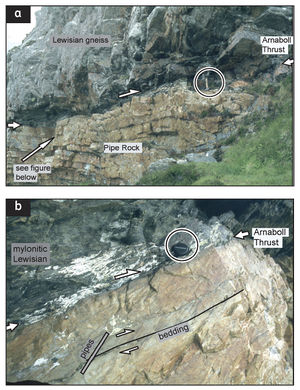The Moine Thrust Belt at Loch Eriboll - an excursion
| From: Strachan, Rob, Friend, Clark, Alsop, Ian, Miller, Suzanne (Editors). A Geological excursion guide to the Moine geology of the Northern Highlands of Scotland.: Edinburgh Geological Society, Glasgow Geological Society in association with NMS Enterprises, 2010. |
By Rob Butler


Excursion 11 The Moine Thrust Belt at Loch Eriboll is composed of the following articles:
- Excursion 11 The Moine Thrust Belt at Loch Eriboll - introduction
- Transect 1: South Eriboll.
- Transect 2: Arnaboll.
- Transect 3: Kempie.
- Transect 4: Creagan Road.
Excursion 11 The Moine Thrust Belt at Loch Eriboll
| Purpose: | Four transects to examine aspects of thrust belt geometry and the evolution of fault rocks. |
| Aspects covered: | Lewisian gneisses, Cambro-Ordovician stratigraphy, imbricate thrusts, duplexes, piggyback stacking and breaching sequences of thrusts, mylonites and other fault rocks. |
| Maps: | OS: Explorer series (1:25,000) sheets 445, 446 and 447; BGS 1:50,000 Scotland sheet 114W, Loch Eriboll. |
| Type of terrain: | Rocky coastlines, moorland, wet valley bottom, steep grassy slopes, scree, mountain crags and bare rock exposures |
| Distance and time: | 2 full days: transect 1 (1 day); transect 2 (2 hours); transect 3 (4 hours); transect 4 (2-3 hours). Allow a further 30-45 minutes for the drive from Durness or Tongue. |
| Short itinerary: | Transect 2 for a major thrust, the Arnaboll Thrust and associated deformation features; transect 1 for a fuller range of geology if only one day is available. |
| Note: all the localities described in this chapter are Sites of Special Scientific Interest and as such are protected. No outcrops should be hammered nor specimens collected, even from float. |
The Loch Eriboll area (Fig.11.8) is hallowed ground not only for Highland geology but also for the discovery of thrust tectonics. It was here in the early 1880s that Charles Lapworth demonstrated that the sequence of rocks was not a simple stratigraphic order, but was repeated by folds and faults (Lapworth, 1883). In accepting Lapworth’s geological interpretations, it was for this area that Geikie (1884) first coined the term ‘thrust’, inspired by the structures on Ben Arnaboll. Lapworth (1885) went on to describe how large shear strains associated with thrusting generate new types of rocks, coining the term ‘mylonite’ for these ‘intensely milled’ rocks. This work not only forms the foundation for much modern work (see Snoke & Tullis, 1998; Law & Johnson, 2010), it also established clearly that the layered structures in metamorphic rocks could be formed by deformation rather than simply mimic original sedimentary bedding. This opened the way for better interpretations of the geological structure of the interiors of mountain belts around the world. Lapworth’s key sites are described here together with spectacular sections across these units at the Moine Thrust. The region is also important internationally for understanding the structure and geometric evolution of thrust belts. Early attempts to model the formation of thrusts using analogue materials were inspired by the spectacular imbricate structures on Foinaven (Cadell, 1888; see Butler, 2004a). A century later the same outcrops provided the type example for duplex structures (Boyer & Elliott, 1982). The whole area is protected as Sites of Special Scientific Interest, recently described by Butler (2009).
The overall aim of the combined transects described here is to introduce the key structural elements of thrust belts at a variety of scales, from the processes that form fault rocks that permit tens of kilometres of displacement on relatively narrow zones of movement, to the ways in which many faults can interact to create wonderfully complex stacks and piles of thrust sheets. Depending on the structural level within the thrust belt, the structures formed vary from simple localised fault zones to the broader zones of mylonites that characterise the higher structural levels of the thrust belt. The thickness of thrust sheets and slices varies considerably also, from a few centimetres where individual beds within the Pipe Rock are imbricated to several hundred metres of gneisses where Lewisian basement has been displaced. Indeed the Moine Thrust Belt is a classic place to study basement involvement in thrust belts (see Butler et al., 2006). Remarkably for such an intensively studied and relatively well-exposed thrust belt, there are still fundamental disagreements between researchers on such matters as the correlation and kinematic significance of certain thrusts and the protoliths of various mylonitic lithologies. The main issues are outlined at the appropriate points in these transects.
References
| At all times follow: The Scottish Access Codeand Code of conduct for geological field work |